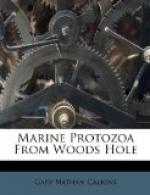Fresh and salt water.
Glenodinium compressa, n. sp. Fig. 21, a, b, c.
This species resembles G. acuminata of Ehrenberg except that it is strongly compressed laterally. The longitudinal furrow extends nearly to the extremity of the animal. It begins as a narrow slit and widens as it progresses upon the left side; it also becomes much deeper on this side and at the bottom of the depression the longitudinal flagellum is inserted. The transverse furrow runs evenly around the body near the upper pole, giving to the shell almost the aspect of an Amphidinium. Brown chromatophores may or may not be arranged radially about a central amylum granule. One striking characteristic is the depth of the two furrows. The nucleus is elongate and somewhat curved; it lies against the posterior wall of the rather thick shell. Not uncommon.
Length 40 mu; breadth 32 mu; width 18 mu.
The posterior end of the animal is often somewhat pointed and this point frequently becomes attached, so that the animal whirls around upon it as upon a pivot.
[Illustration: Fig. 21 a, b, c.—Glenodinium compressa, n. sp.]
Glenodinium cinctum Ehr. Fig. 22.
The body is globular, smooth, and homogeneous. Brown chromatophores arranged radially, each in the form of a cone, the base of which rests against the shell while the points turn inward. A bright-red eye-spot may or may not be present; when present it is placed near the junction of the two furrows. The longitudinal furrow is small. Fresh water and salt.
Length and diameter the same, 21 mu.
This species was observed by Peck ’93.
[Illustration: Fig. 22.—Glenodinium cinctum.]
Genus PERIDINIUM Ehr. ’32, Stein ’83.
(Claparede & Lachmann ’58; Bergh ’81;
Pouchet ’83; ’85; Gourret ’88;
Buetschli ’86.)
The form is globular, ovoid or elongate, the apex frequently drawn out into a long tube. The transverse and longitudinal furrows are quite distinct, the former having often a spiral course about the body. The two halves of the body are similar, the posterior being somewhat shorter; the anterior half has seven equatorial plates, an oral plate, two lateral apical plates, and one or two dorsal plates. The two antapical plates frequently have a tooth-like process. The bodies are colorless, green or brown.
Fresh and salt water.
Peridinium digitale Pouchet. Fig. 23.
Synonyms: Protoperidinium digitale Pouchet; Protoperidinium Bergh p. p.; P. divergens Peck.
The shell is covered with pits of large size. The posterior part is hemispherical and surmounted by a single horn or spine. The transverse furrow is very oblique, and its two extremities are united by a sigmoid longitudinal furrow. The anterior half bears two spines or horns of different size, and variable. The nucleus is spherical or ellipsoidal and placed in the posterior half of the shell.




